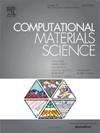Lorenz number and electronic thermoelectric figure of Merit: Thermodynamics and direct DFT calculations
IF 3.1
3区 材料科学
Q2 MATERIALS SCIENCE, MULTIDISCIPLINARY
引用次数: 0
Abstract
The Lorenz number () contained in the Wiedemann–Franz law represents the ratio of two kinetic parameters of electronic charge carriers: the electronic contribution to the thermal conductivity () and the electrical conductivity (σ), and can be expressed as where is temperature. We demonstrate that the Lorenz number simply equals to the ratio of two thermodynamic quantities: the electronic heat capacity ( and the electrochemical capacitance ( through , a purely thermodynamic quantity, and thus it can be calculated solely based on the electron density of states of a material. It is shown that our thermodynamic formulation for the Lorenz number leads to: i) the well-known Sommerfeld value at low temperature limit; ii) the Drude value at the high temperature limit with the free electron gas model, and iii) possible higher values than the Sommerfeld limit for certain semiconductors. Importantly, we demonstrate that the purely electronic contribution to the thermoelectric figure-of-merit can be directly and efficiently computed using high-throughput density functional theory (DFT) calculations, eliminating the need for the computationally intensive Boltzmann transport theory for electronic thermal and electrical conductivities. For thermoelectric materials with low or negligible lattice thermal conductivity, this approach provides a rapid and reliable estimation of the thermoelectric figure-of-merit. These findings highlight the utility of the proposed methodology in high-throughput workflows for thermoelectric material discovery and screening.

求助全文
约1分钟内获得全文
求助全文
来源期刊

Computational Materials Science
工程技术-材料科学:综合
CiteScore
6.50
自引率
6.10%
发文量
665
审稿时长
26 days
期刊介绍:
The goal of Computational Materials Science is to report on results that provide new or unique insights into, or significantly expand our understanding of, the properties of materials or phenomena associated with their design, synthesis, processing, characterization, and utilization. To be relevant to the journal, the results should be applied or applicable to specific material systems that are discussed within the submission.
 求助内容:
求助内容: 应助结果提醒方式:
应助结果提醒方式:


